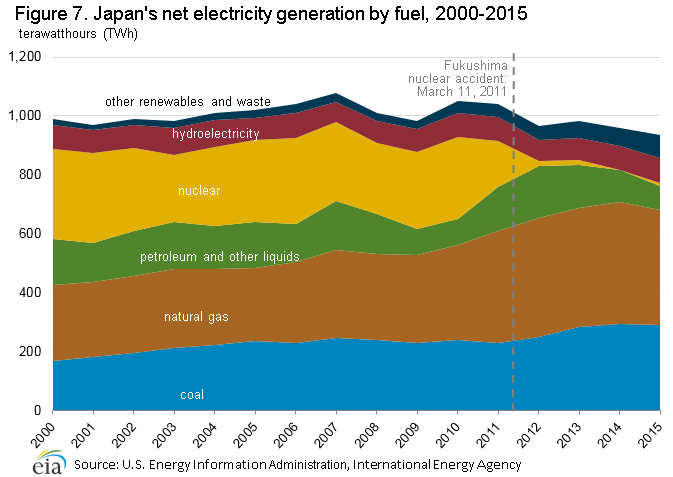Japan plans to build as many as 22 new coal-fired power plants at 17 different sites in the next five years despite its commitment to reduce carbon dioxide emissions. Under the Paris climate accord, Japan committed to reduce its greenhouse gas emissions 26 percent by 2030 compared to 2013 levels. Japan currently relies on coal for over a third of its power generation needs. While older coal plants will begin retiring, eventually reducing coal dependency somewhat, the country still plans to meet over a quarter of its electricity demand from coal in 2030. Japan is reliant on imports for most of its energy needs, and it has been increasing its coal consumption as it has been weaning itself off of foreign oil following the oil price shocks of the 1970s. Coal was also a preferred choice of fuel for new electricity generation after the Fukushima nuclear accident and is part of the country’s fuel diversification plans. Japan is second to China in financing coal plants in developing nations.
Japan is portraying this summer’s Olympic Games in Tokyo as one of the greenest ever, indicating that electricity for the Games will come from renewable sources. The country is using the Olympic Games to underscore its transition to a more climate-resilient economy, displaying innovations like roads that reflect heat. Critics note, however, that despite its innovations, Japan will start operating five new coal-fired power plants that will emit more carbon dioxide than what the Olympic Games can offset with renewable energy.
Japan’s Electricity Diversification
Fossil fuels (coal, oil, and natural gas) account for about four-fifths of Japan’s electricity needs, and renewable sources of energy account for about 16 percent, with hydropower contributing the largest share. Reliance on nuclear energy, which once provided about a third of Japan’s power generation, dropped to 3 percent in 2017.

Coal-Related Projects in Japan
The Yokosuka project consists of two coal units to be constructed at the site of an oil-powered power station, operated by Tokyo Electric Power. That oil power station was shuttered in 2009, but was recalled to operation after the Fukushima accident, when an earthquake and tsunami badly damaged a seaside nuclear facility owned by Tokyo Electric in 2011. Tokyo Electric had to start up two of the eight Yokosuka oil-powered units as an emergency measure. They were shut down again in 2017. Tokyo Electric declared that the coal units to be built on the site did not need a full environmental review because they were being built on the same site as the oil-burning facilities.
Japan’s answer to carbon dioxide emissions from coal is to invest in carbon capture and storage (CCS) technology, but that technology is not yet commercially available because of its high cost. A consortium of firms called Japan CCS Co. is completing a three-year demonstration project involving 300,000 tons of carbon dioxide emitted from an oil refinery in Hokkaido this fiscal year. CCS costs as much as ¥7,300 ($66.51) for 1 ton of carbon dioxide removal. For 300,000 tons of carbon dioxide removal, the cost is almost $20 million. Japan wants to capture and store 100 million tons of carbon dioxide per year beginning in 2020. Japan’s trade ministry estimates that there is potential to store 146 billion tons of carbon dioxide in the surrounding waters of Japan.
Some of Japan’s coal projects were scrapped because they did not make economic sense. Japan had a plan to construct 30 new coal-fired plants totaling 16.7 gigawatts of output by the end of March 2018 as part of an effort to reduce carbon dioxide emissions by replacing aging units with more efficient units. Japan is promoting “clean coal” and mandating all new plant construction adopt the best available technology to reduce the environmental footprint. Japan is also spearheading an effort to commercialize integrated gasification combined cycle technology, which achieves higher power-generation efficiency through the gasification of coal. According to Japanese estimates, if all the existing coal plants in Asia and the United States are fitted with ultra-supercritical technology, global carbon dioxide emissions would be reduced by 1.2 billion tons a year—close to the total annual emissions of Japan.
With Japan’s “clean coal” technology, and compared with aging units built before 2002, emissions of nitrogen oxide, sulfur oxide, and particulate matter from newer plants have fallen by 92, 83, and 90 percent, respectively.
Conclusion
Despite its commitment to the Paris climate accord, Japan is building state-of-the-art coal-fired power plants in its own country and financing them in developing countries. Japan has few natural resources of its own and has to import most of its energy. As a result, diversification of fuels is important to the country. By replacing old coal units with best available technology, it is still reducing carbon dioxide emissions as well as emissions of nitrogen oxide, sulfur dioxide, and particulate matter.